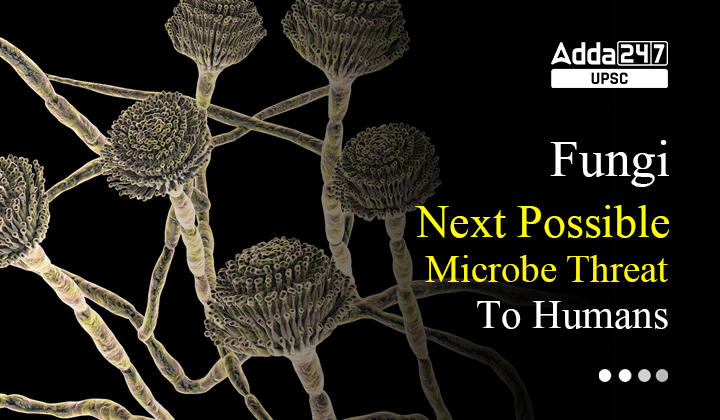Table of Contents
About Fungi
- Fungi are one of the categories in the 5 kingdom classification.
- The other 4 are Protista (the single-celled eukaryotes), Plants; Animals, and prokaryotes(Monera).
Why in News?
- World Health Organization (WHO) in its recently published report highlighted 19 fungi that represent the greatest threat to public health.
- The list known as Fungal priority pathogens list (FPPL)
What is FPPL?
- The fungal priority pathogens list (FPPL) is the first global effort to systematically prioritize fungal pathogens, considering the unmet research and development (R&D) needs and the perceived public health importance.
What is a Fungus?
- Fungi are multicellular organisms consisting of eukaryotic cells.
- There are more than 100,000 varieties of fungi.
- They have no mechanisms for locomotion.
- Fungi get nutrients by absorption and range in size from microscopic to bigger ones like mushrooms.
- They usually act as decomposers by obtaining their energy from the chemical breakdown of dead organisms as well as from animal and plant waste products.
- Fungi are one of the categories in the 5 kingdom classification. The other 4 are Protista (the single-celled eukaryotes),Plants; Animals and the prokaryotes(Monera). The major group of microbes that causes diseases to humans are Viruses, Prions, Bacteria, Fungi, Protozoa, and Helminths(worms).
How Fungi is a threat?
- As per WHO, Fungal pathogens are a major threat to public health as they are becoming increasingly common and resistant to treatment.
- Currently, only four classes of systemic antifungal medicines (azoles, echinocandins, pyrimidines and polyenes) are used in clinical practice, and only a few others are under development.
- Although existing antifungal medicines are effective, they are associated with a plethora of adverse effects.
- Most fungal pathogens lack rapid and sensitive diagnostics and those that exist are not widely available or affordable globally.
What are the Reasons for the Rise in fungi?
- Due to global warming and the increase in international travel and trade, the incidence and geographic range of fungal diseases are expanding worldwide. During the COVID-19 pandemic, the reported incidence of invasive fungal infections increased significantly among hospitalized patients.
- As the fungi that cause common infections (such as candida oral and vaginal thrush) become increasingly resistant to treatment, risks for the development of more invasive forms of infections in the general population are also growing.
- Resistance to antifungal medicines is partly driven by inappropriate antifungal use across the One Health spectrum. For example, the injudicious use of antifungals in agriculture was linked to the rising rates of azole-resistant Aspergillus fumigatus infections.
- Despite the growing concern, fungal infections receive very little attention and resources, leading to a scarcity of quality data on fungal disease distribution and antifungal resistance patterns.
- As a result, the exact burden of fungal diseases and antifungal resistance are unknown, and the response is therefore undermined.
What are Invasive Fungal Diseases?
- The invasive forms of these fungal infections often affect severely ill patients and those with significant underlying immune system-related conditions.
- Cases of invasive fungal disease (IFD) are rising as the at-risk population continues to expand.
- This is due to many factors, including advancements in modern medicine and accessibility to therapies and interventions that impair the immune system, such as chemotherapy and immunotherapy for cancer, and solid organ transplantation.
Three priority categories
- The WHO FPPL list is divided into three categories: Critical, high and medium priority.
- The fungal pathogens of in each priority category are so ranked primarily due to their public health impact and/or emerging antifungal resistance risk.
- While recognizing these critical pathogens as of public health concern globally, WHO emphases that the FPPL must be interpreted and contextualized carefully, as some endemic pathogens could be of more concern in their respective regional or local contexts.
Critical Category
⦁ Cryptococcus neoformans: Cryptococcus neoformans is a globally distributed pathogenic yeast which lives in the environment (soil, decaying wood). After inhalation of fungal cells from the environment, C. neoformans can infect humans.
⦁ Candida auris: It is a globally distributed pathogenic yeast that can cause invasive candidiasis of the blood (candidaemia), heart, central nervous system, eyes, bones, and internal organs. Invasive candidiasis is a serious nosocomial infection that especially affects critically ill and immunocompromised patients, such as cancer or bone marrow and organ transplant patients.
⦁ Aspergillus fumigatus: It is a ubiquitous environmental mould that can infect humans and cause aspergillosis. It is inhaled from the environment, predominantly causing pulmonary disease, but can disseminate to other sites, such as the brain. Aspergillosis is a term used for a wide spectrum of infections that range from allergic reactions, colonization, and semi-invasive disease to acute invasive aspergillosis.
⦁ Candida albicans: It is a globally distributed pathogenic yeast. It is a common member of the human microbiota (mouth, throat, gut, vagina, and skin) and produces no harm in healthy conditions. However, it can multiply in these mucosae or invade other tissues, producing disease. In mucosae, it produces diseases such as oropharyngeal candidiasis, oesophageal candidiasis, vulvovaginal candidiasis and cutaneous candidiasis.
Way Forward
- The FPPL report underscores strategies for policymakers, public health professionals, and other stakeholders. The strategies proposed in the report are collectively aimed at generating evidence and improving response to these fungal priority pathogens including preventing the development of antifungal drug resistance.
- The primary recommended actions are focused on: (1) strengthening laboratory capacity and surveillance; (2) sustaining investments in research, development, and innovation; and (3) enhancing public health interventions for prevention and control.
Analysis Of Down To Earth Magazine: Microbes To Improve Crop Yield
Anti Microbial Resistance in India: WHO Report on AMR Vaccines


 TSPSC Group 1 Question Paper 2024, Downl...
TSPSC Group 1 Question Paper 2024, Downl...
 TSPSC Group 1 Answer key 2024 Out, Downl...
TSPSC Group 1 Answer key 2024 Out, Downl...
 Cabinet Ministers of India 2024, New Cab...
Cabinet Ministers of India 2024, New Cab...







